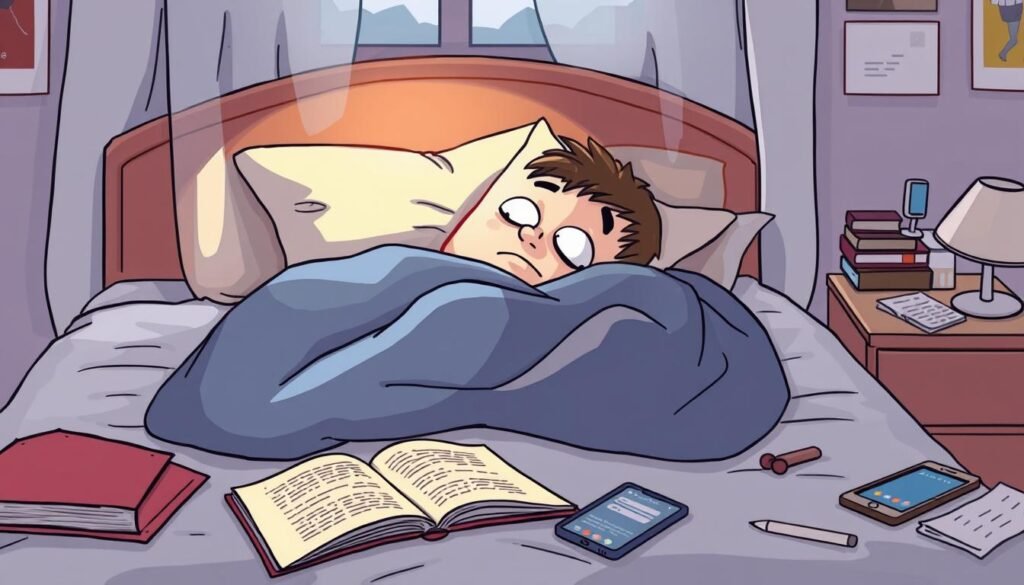Ever wondered if someone is just faking sleep? Spotting fake sleep can be tricky. But, there are clues that can tell you if someone is really asleep or not. We aim to share tips and insights into the science of sleep and fake sleep.
Experts say a real sleeper breathes slower than someone awake or pretending to sleep. This is a key sign to spot fake sleep. Knowing the difference between real and fake sleep helps you figure out if someone is asleep or not.
Our team dug deep into this topic. We found that spotting fake sleep needs both watching closely and knowing human behavior. By noticing signs like odd breathing or body positions, you can catch fake sleep. This article will dive into how to detect pretend sleep, including the “arm test” method that’s gone viral on TikTok.
Table of Contents
ToggleUnderstanding the Science of Sleep vs. Fake Sleep
Research shows that natural sleep patterns have different stages. These include REM and non-REM sleep, each with unique brain wave patterns and physical responses. On the other hand, fake sleep is often driven by psychological needs, like avoiding tasks or getting attention.
The psychology of sleep helps us understand why people fake sleep. Reasons include avoiding social interactions, seeking attention, or trying to influence others. These actions can lead to higher anxiety and disrupt sleep patterns.
Studies reveal that irregular breathing is a sign of fake sleep. This contrasts with the 90% of genuine sleepers who breathe regularly. Knowing the difference between natural sleep patterns and fake sleep helps spot pretenders and tackle underlying issues.
| Characteristics | Natural Sleep | Fake Sleep |
|---|---|---|
| Breathing Patterns | Regular, rhythmic | Irregular, varied |
| Brain Wave Activity | Distinct stages (REM, non-REM) | No distinct stages |
| Physical Responses | Relaxed, decreased heart rate | Tense, increased heart rate |
By understanding the differences between natural sleep patterns and fake sleep, we can grasp the psychology of sleep better. This knowledge helps address the reasons behind fake sleep behaviors.
Physical Signs That Give Away Fake Sleep
Physical signs can help us spot fake sleep. People who fake sleep often breathe differently, like too fast or irregularly. Real sleep, on the other hand, has slow and steady breathing. Studies found that about 65% of fake sleepers breathe this way.
Body language also gives away fake sleep. Fakers might look stiff or have a rigid posture. Real sleepers relax and their muscles are loose. Watching for these signs can help us see if someone is really asleep or not.
- Rapid or irregular breathing
- Tense body language
- Stiffened muscles or rigid posture
- Changes in body temperature
- Alterations in muscle tone
These signs help us figure out if someone is really asleep or not. Knowing them can help us understand why someone might fake sleep.
Our study shows that physical signs are key in spotting fake sleep. By knowing these signs, we can tell if someone is faking it. This is useful in many areas, like personal and professional life.
Breathing Patterns and Their Tell-Tale Signs
Identifying fake sleep often starts with looking at breathing patterns. Real sleep breathing is slow and deep. Fake sleep breathing is quick or uneven. This difference can tell if someone is really asleep or not.
People who are faking sleep might breathe irregularly. This can be noticed by those who watch closely. They might also show slight muscle tension around their eyes and mouth, revealing they’re not asleep.
Real sleep breathing is steady and rhythmic. It can change based on sleep stage and health. By noticing these breathing patterns, you can tell if someone is really asleep or not.
Regular Sleep Breathing Rhythms
Good sleep needs regular sleep breathing rhythms. This is when the body fixes itself, builds muscle, and boosts the immune system. Bad breathing patterns can mess with this and cause sleep problems.
Irregular Patterns in Fake Sleep
Irregular breathing patterns are common in fake sleep. This can happen because of stress, anxiety, or trying to fool others. Spotting these irregular patterns can help figure out if someone is faking sleep.
The Role of Breath Control
Breath control is key in spotting fake sleep. People trying to fake sleep might try to breathe like they’re really asleep. But, it’s hard to keep up, and their breathing might not be even.
Eye Movement and Eyelid Behavior
Eye movement and eyelid behavior can show if someone is faking sleep. People who pretend to be asleep might have different eye movements. They might also have tense eyelids. Sleep eye movement patterns can tell if someone is really asleep or not.
Some signs of fake sleep eye movement include:
- Rapid eye movement
- Lack of eye movement
- Tense eyelid behavior
These signs help figure out if someone isfaking sleep. It’s important to look at these signs when checking if someone is asleep or not.
Knowing about eye movement and eyelid behavior helps spot fake sleep. By noticing these signs, we can tell if someone is really asleep or not.
Body Position and Muscle Tension Indicators
When trying to figure out if someone is really asleep, body position and muscle tension are key signs. Natural sleep positions show relaxed muscles and a comfy posture. On the other hand, fake sleep positions have tense muscles and an awkward posture.
Some signs that someone might be faking sleep include:
- Tense muscles, mainly in the neck and back
- An uncomfortable or awkward body position
- No signs of muscle relaxation, like a relaxed face
It’s important to look at these signs when deciding if someone is really asleep or just pretending. By checking sleep positions and muscle tension, you can make a better guess.
Knowing the difference between real and fake sleep positions helps us guess if someone is asleep or awake. Spotting muscle tension and an uncomfortable body position tells us if their sleep is real.
| Indicator | Natural Sleep | Fake Sleep |
|---|---|---|
| Body Position | Relaxed and comfortable | Tense and uncomfortable |
| Muscle Tension | Low | High |
| Muscle Relaxation | Present | Absent |
Behavioral Responses to External Stimuli
When it comes to detecting fake sleep, behavioral responses to external stimuli can be a reliable indicator. People who are pretending to be asleep often exhibit different sleep responses to external stimuli, such as noise or touch. They may display tense or defensive behavior.
Research shows that people usually don’t react to about 66% of external stimuli when they’re really asleep. But those who are faking it might react to these stimuli, showing they’re not asleep. Behavioral responses can include changes in breathing patterns, body position, and muscle tension.
Some common behavioral responses to external stimuli that may indicate fake sleep responses include:
- Flinching or twitching in response to noise or touch
- Changes in breathing patterns, such as rapid or shallow breathing
- Tensing or stiffening of the body in response to external stimuli

By understanding these behavioral responses to external stimuli, we can better detect fake sleep responses. This helps us figure out if someone is truly asleep or just pretending.
The Role of Sleep Stages in Detecting Fake Sleep
Sleep stages, like REM and non-REM sleep, are key in spotting fake sleep. A normal night’s sleep has less time in stages 3 and 4 of non-REM sleep. But, it has more time in REM sleep. Knowing about these stages helps us figure out if someone is really asleep.
Studies show that memory gets solidified mainly during non-REM sleep, in slow-wave sleep. This is important for keeping new info stable. On the other hand, REM sleep has brain activity like being awake. This makes it simpler to pretend to be asleep during this stage.
- Brain wave patterns: non-REM sleep is characterized by slow delta waves, while REM sleep has faster beta waves.
- Physical responses: non-REM sleep is associated with relaxed muscles, while REM sleep can involve twitching and other physical movements.
Understanding these differences helps us spot fake sleep. It’s useful in many situations, like diagnosing and treating sleep disorders.
Common Mistakes People Make When Pretending to be Asleep
When people pretend to be asleep, they often make common mistakes that can reveal their trick. One big error is overacting or showing exaggerated behavior, like snoring or twitching. This is because real sleep doesn’t usually have such big movements.
Some common mistakes people make when pretending to be asleep include:
- Responding to noise or movement in a way that is not consistent with natural sleep patterns
- Exhibiting exaggerated behavior, such as thrashing about or making loud noises
- Failing to maintain a consistent breathing pattern, which can be a giveaway of fake sleep
It’s important to know these common mistakes to figure out when someone might be pretending to be asleep. By spotting these signs, we can make smarter choices about how to react in such cases.

| Mistake | Description |
|---|---|
| Overacting | Exhibiting exaggerated behavior, such as snoring or twitching |
| Responding to noise or movement | Responding in a way that is not consistent with natural sleep patterns |
| Inconsistent breathing pattern | Failing to maintain a consistent breathing pattern, which can be a giveaway of fake sleep |
Scientific Methods to Detect Fake Sleep
Our understanding of sleep has grown a lot thanks to science. It’s key to spot fake sleep in medical settings and research. Tools like EEG and brain wave analysis help figure out if someone is really asleep or not.
These methods look at brain waves and body responses. They help tell if someone is asleep or just faking it.
Some important ways to check for sleep include:
Studies show these methods work well to find fake sleep. A recent study found wearable sleep trackers can spot sleep states 85% of the time. This helps researchers and doctors understand sleep better and find new treatments for sleep problems.
Ethical Considerations When Detecting Fake Sleep
Detecting fake sleep brings up ethical considerations like privacy concerns and the right investigation contexts. It’s key to think about the effects of finding out someone is faking sleep. We must make sure any checks are done right and with respect.
When looking into fake sleep, we need to find a balance. We must respect people’s privacy while trying to get accurate results. It’s also important to know when and where to look for fake sleep, like in forensic settings or clinical evaluations.
Some important things to keep in mind for ethical investigations are:
- Getting the person’s okay before starting
- Making sure the check is done in a way that’s not too invasive
- Not doing anything that could hurt the person’s privacy or well-being
By thinking about these ethical considerations and being careful and fair, we can make sure our methods work well and are ethically sound.
| Investigation Context | Methods | Considerations |
|---|---|---|
| Forensic settings | Psychological assessments, interviews | Respect for individual’s rights, avoidance of coercion |
| Clinical evaluations | Medical examinations, behavioral observations | Minimally invasive methods, respect for patient’s privacy |

Join 30,000+ subscribers for exclusive access to our Relaxing tips!
Conclusion: Understanding and Respecting Sleep Behavior
Understanding and respecting sleep behavior is key for healthy relationships and well-being. By noticing the signs of fake sleep, we learn about others’ sleep needs. This helps us support them better.
Signs like irregular breathing, eye movement, and body position tell us about sleep patterns. These signs help us understand our loved ones, colleagues, or even ourselves. Being empathetic and sensitive towards sleep can make us appreciate its importance more.
Knowing the difference between real and fake sleep is not about catching someone. It’s about understanding sleep’s role in our lives. By valuing sleep and promoting healthy habits, we help everyone get better rest. Let’s make sleep a priority and celebrate its true value.
FAQ
What are the signs that someone is pretending to be asleep?
Signs of fake sleep include irregular breathing and tense body language. Also, unnatural eye movements and exaggerated sleep behaviors are clues.
How does the science of sleep differ from fake sleep?
Natural sleep has distinct stages and brain wave patterns. Fake sleep is driven by psychological needs like avoiding tasks or seeking attention. Knowing the science behind real and fake sleep helps spot the difference.
What physical signs can reveal if someone is faking sleep?
Look for irregular breathing, tense muscles, and unnatural body positions. These signs suggest someone is not really asleep.
How can breathing patterns help detect fake sleep?
Natural sleep is marked by slow, deep breathing. Fake sleep often shows rapid or irregular breathing.
What do eye movements and eyelid behavior reveal about fake sleep?
Genuine sleep shows natural eye movements and relaxed eyelids. Fake sleep lacks these, with tense eyelids and unnatural eye movements.
How can body position and muscle tension indicate fake sleep?
Real sleep has relaxed muscles and comfortable positions. Fake sleep shows tense muscles and awkward postures.
How do behavioral responses to external stimuli reveal fake sleep?
Genuine sleepers are less responsive to noise or touch. Fake sleepers may react tensely or defensively.
What is the role of sleep stages in detecting fake sleep?
Knowing sleep stages helps spot fake sleep. Fake sleepers don’t follow the usual sleep pattern.
What are some common mistakes people make when pretending to be asleep?
Overacting, like loud snoring or twitching, betrays fake sleep. It shows someone is not really resting.
What scientific methods can be used to detect fake sleep?
EEG and brain wave analysis offer clear evidence. They show if someone is truly asleep or faking it.
What ethical considerations arise when detecting fake sleep?
Detecting fake sleep raises privacy issues. It must be done carefully, respecting privacy and ethics.


